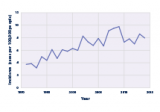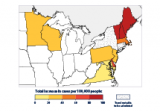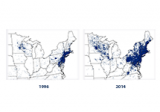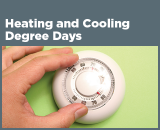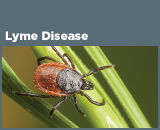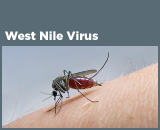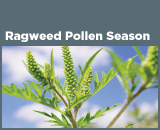Climate Change Indicators: Lyme Disease
This indicator tracks the rate of reported Lyme disease cases across the United States.
-
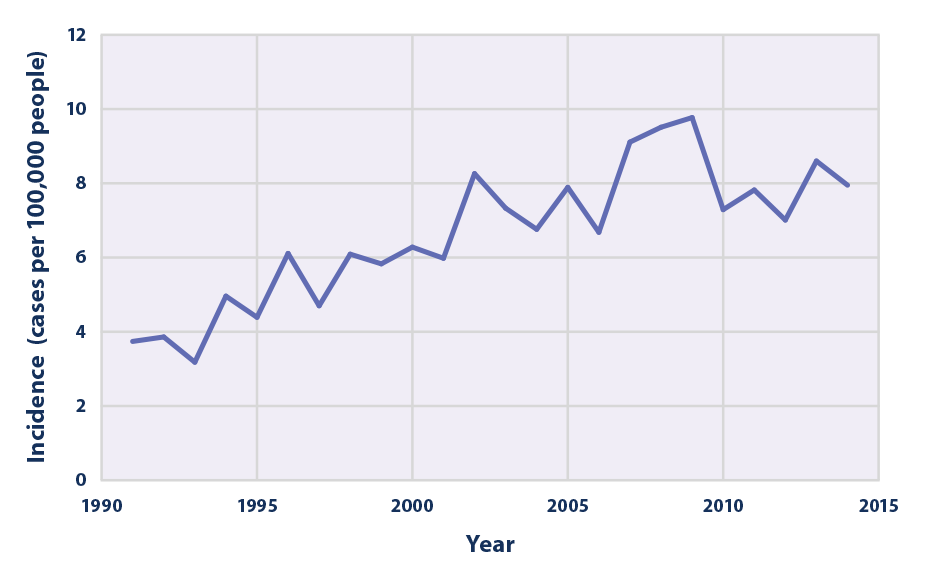
This figure shows the annual incidence of Lyme disease, which is calculated as the number of new cases per 100,000 people. The graph is based on cases that local and state health departments report to CDC’s national disease tracking system.
Data source: CDC, 20158
Web update: August 2016 -
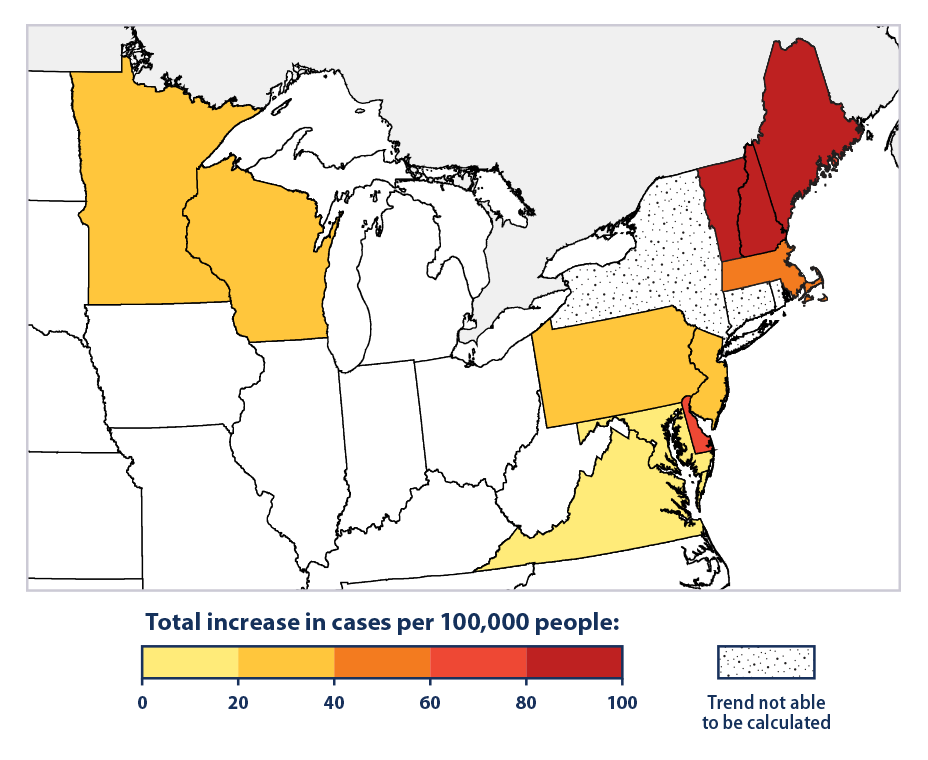
This map shows how reported Lyme disease incidence has changed by state since 1991, based on the number of new cases per 100,000 people. The total change has been estimated from the average annual rate of change in each state. This map is limited to the 14 states where Lyme disease is most common, where annual rates are consistently above 10 cases per 100,000 people. Connecticut, New York, and Rhode Island had too much year-to-year variation in reporting practices to allow trend calculation.
Data source: CDC, 20159
Web update: August 2016 -
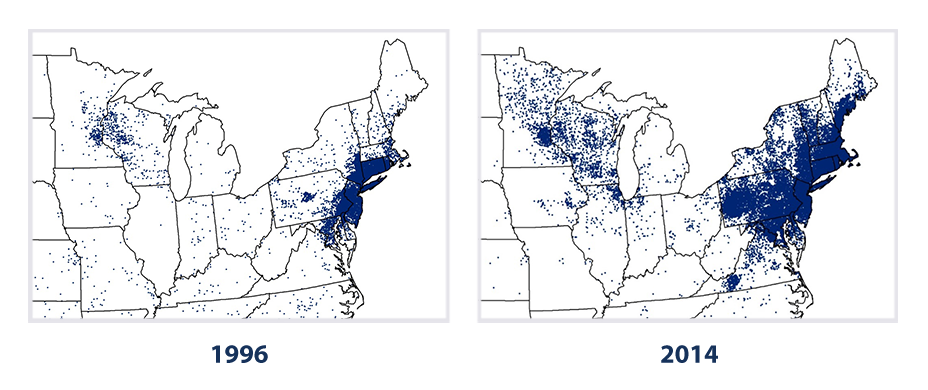
These maps show the distribution of reported cases of Lyme disease in 1996 and 2014. Each dot represents an individual case placed according to the patient’s county of residence, which may be different than the county of exposure. The year 1996 was chosen as a reasonable starting point for comparison with recent years. These maps focus on the parts of the United States where Lyme disease is most common.
Data source: CDC, 201510
Web update: August 2016
Key Points
- The incidence of Lyme disease in the United States has approximately doubled since 1991, from 3.74 reported cases per 100,000 people to 7.95 reported cases per 100,000 people in 2014 (see Figure 1).
- Among the states where Lyme disease is most common, New Hampshire, Maine, and Vermont have experienced the largest increases in reported case rates since 1991, followed by Delaware and Massachusetts (see Figure 2). On average, these five states now report 50 to 100 more cases per 100,000 people than they did in 1991.
- Driven by multiple factors, the number and distribution of reported cases of Lyme disease have increased over time (see 1996 and 2014 maps).
Background
Lyme disease is a bacterial illness that can cause fever, fatigue, joint pain, and skin rash, as well as more serious joint and nervous system complications. Lyme disease is the most common vector-borne disease (that is, a disease transmitted by mosquitoes, ticks, or fleas) in the United States. In recent years, approximately 20,000–30,000 confirmed cases of Lyme disease per year have been reported to the Centers for Disease Control and Prevention.1 However, the actual number of illnesses is likely greater than what is reported to health officials.2 Lyme disease is transmitted through the bite of certain species of infected ticks (referred to commonly as deer ticks) that carry the bacteria that cause Lyme disease. These ticks live not only on deer, but also on rodents, birds, and other host animals. Deer do not harbor the bacteria that cause Lyme disease, but certain other hosts such as white-footed mice do, and ticks pick up the bacteria by feeding on these infected hosts.
Climate is just one of many important factors that influence the transmission, distribution, and incidence of Lyme disease; however, studies provide evidence that climate change has contributed to the expanded range of ticks,3 increasing the potential risk of Lyme disease, such as in areas of Canada where the ticks were previously unable to survive. The life cycle and prevalence of deer ticks are strongly influenced by temperature.4,5 For example, deer ticks are mostly active when temperatures are above 45˚F, and they thrive in areas with at least 85-percent humidity. Thus, warming temperatures associated with climate change are projected to increase the range of suitable tick habitat and are therefore one of multiple factors driving the observed spread of Lyme disease.6 Because tick activity depends on temperatures being above a certain minimum, shorter winters could also extend the period when ticks are active each year, increasing the time that humans could be exposed to Lyme disease. Unlike some other vector-borne diseases, tick-borne disease patterns are generally less influenced by short-term changes in weather (weeks to months) than by longer-term climate change.
Other factors that affect the number of Lyme disease cases include changes in the populations of host species (particularly deer), which affect tick population size. The percentage of ticks that are infected depends on the prevalence and infection rates of white-footed mice and certain other hosts. Host species populations and habitats can be affected by climate change and other ecosystem disturbances. Human exposure to infected ticks is also influenced by multiple factors, including changes in the proximity of human populations to ticks and other hosts, increased awareness of Lyme disease, and modified behaviors, such as spending less time outdoors, taking precautions against being bitten, and checking more carefully for ticks. People who work outdoors, like farmers and landscapers, may be especially at risk.7
About the Indicator
This indicator looks at the incidence of Lyme disease, which reflects the rate of new cases contracted in a given geographic area and time period. Incidence is typically calculated as the number of cases per 100,000 people per year. Annual Lyme disease totals and rates for each state were provided by the Centers for Disease Control and Prevention. The original data were collected by state and local health departments, which track confirmed cases of Lyme disease that are diagnosed by health care providers and report these cases to the National Notifiable Diseases Surveillance System. Nationwide reporting of Lyme disease began in 1991.
Figure 1 shows the national incidence of Lyme disease since 1991, and Figure 2 shows trends in incidence over time in 14 states that collectively account for about 95 percent of the nation’s reported cases. To illustrate changes in the distribution of reported cases over time, maps of the years 1996 and 2014 are presented side by side.
Indicator Notes
For consistency, this indicator includes only data for confirmed cases of Lyme disease that are reported to CDC, not cases that are considered “probable.” Changes in diagnosing practices and awareness of the disease over time can affect trends, especially considering that Lyme disease can be difficult to diagnose. Cases are reported based on the patient’s county of residence, which is not necessarily the place where they were infected. Risk of infection is focused in certain regions of the country, and confirmed reports from low-incidence states are often the result of travel to an area of higher incidence. Evidence suggests that expanding ranges of ticks in certain northern states may be more related to a warming climate than expanding ranges in southern states.11,12 Because of the many factors affecting tick populations and reporting of Lyme disease, however, this indicator does not provide sufficient information to determine what proportion of the observed changes in Lyme disease incidence is directly driven by climate change. Further study is critical to improving the usefulness of this indicator and informing decisions affecting public health. For information on prevention, symptoms, and treatment of Lyme disease, see: www.cdc.gov/lyme.
Data Sources
All three figures are based on publicly available Lyme disease data compiled by the Centers for Disease Control and Prevention at: www.cdc.gov/lyme/stats/index.html. Incidence was calculated using mid-year population estimates from the U.S. Census Bureau.13,14
Technical Documentation
References
1 CDC (Centers for Disease Control and Prevention). 2015. Lyme disease data and statistics. www.cdc.gov/lyme/stats/index.html. Accessed December 2015.
2 CDC (Centers for Disease Control and Prevention). 2013. CDC provides estimate of Americans diagnosed with Lyme disease each year. www.cdc.gov/media/releases/2013/p0819-lyme-disease.html.
3 Beard, C.B., R.J. Eisen, C.M. Barker, J.F. Garofalo, M. Hahn, M. Hayden, A.J. Monaghan, N.H. Ogden, and P.J. Schramm. 2016. Chapter 5: Vector-borne diseases. The impacts of climate change on human health in the United States: A scientific assessment. U.S. Global Change Research Program. https://health2016.globalchange.gov.
4 Beard, C.B., R.J. Eisen, C.M. Barker, J.F. Garofalo, M. Hahn, M. Hayden, A.J. Monaghan, N.H. Ogden, and P.J. Schramm. 2016. Chapter 5: Vector-borne diseases. The impacts of climate change on human health in the United States: A scientific assessment. U.S. Global Change Research Program. https://health2016.globalchange.gov.
5 Leighton, P.A., J.K. Koffi, Y. Pelcat, L.R. Lindsay, and N.H. Ogden. 2012. Predicting the speed of tick invasion: An empirical model of range expansion for the Lyme disease vector Ixodes scapularis in Canada. J. Appl. Ecol. 49(2): 457-464.
6 Beard, C.B., R.J. Eisen, C.M. Barker, J.F. Garofalo, M. Hahn, M. Hayden, A.J. Monaghan, N.H. Ogden, and P.J. Schramm. 2016. Chapter 5: Vector-borne diseases. The impacts of climate change on human health in the United States: A scientific assessment. U.S. Global Change Research Program. https://health2016.globalchange.gov.
7 Gamble, J.L., J. Balbus, M. Berger, K. Bouye, V. Campbell, K. Chief, K. Conlon, A. Crimmins, B. Flanagan, C. Gonzalez-Maddux, E. Hallisey, S. Hutchins, L. Jantarasami, S. Khoury, M. Kiefer, J. Kolling, K. Lynn, A. Manangan, M. McDonald, R. Morello-Frosch, M.H. Redsteer, P. Sheffield, K. Thigpen Tart, J. Watson, K.P. Whyte, and A.F. Wolkin. 2016. Chapter 9: Populations of concern. The impacts of climate change on human health in the United States: A scientific assessment. U.S. Global Change Research Program. https://health2016.globalchange.gov.
8 CDC (Centers for Disease Control and Prevention). 2015. Lyme disease data and statistics. www.cdc.gov/lyme/stats/index.html. Accessed December 2015.
9 CDC (Centers for Disease Control and Prevention). 2015. Lyme disease data and statistics. www.cdc.gov/lyme/stats/index.html. Accessed December 2015.
10 CDC (Centers for Disease Control and Prevention). 2015. Lyme disease data and statistics. www.cdc.gov/lyme/stats/index.html. Accessed December 2015.
11 Diuk-Wasser, M.A., A.G. Hoen, P. Cislo, R. Brinkerhoff, S.A. Hamer, M. Rowland, R. Cortinas, G. Vourc'h, F. Melton, G.J. Hickling, J.I. Tsao, J. Bunikis, A.G. Barbour, U. Kitron, J. Piesman, and D. Fish. 2012. Human risk of infection with Borrelia burgdorferi, the Lyme disease agent, in eastern United States. Am. J. Trop. Med. Hyg. 86(2):320–327.
12 Stromdahl, E.Y., and G.J. Hickling. 2012. Beyond Lyme: Aetiology of tick-borne human diseases with emphasis on the south-eastern United States. Zoonoses Public Hlth. 59(Supplement 2):48–64.
13 U.S. Census Bureau. 2015. Population estimates: Intercensal estimates. Accessed December 3, 2015. www.census.gov/popest/data/intercensal/index.html.
14 U.S. Census Bureau. 2015. Population estimates: Current estimates data. Accessed December 3, 2015. www.census.gov/popest/data/index.html.

